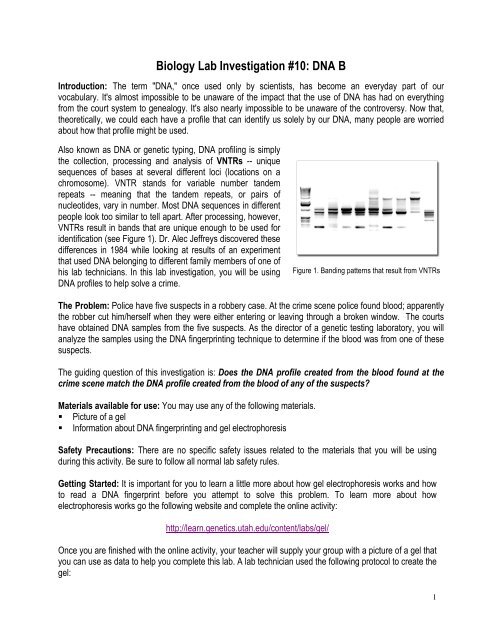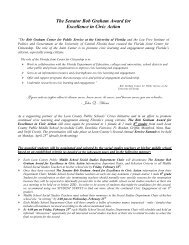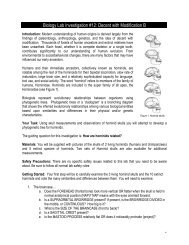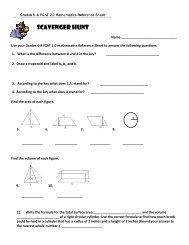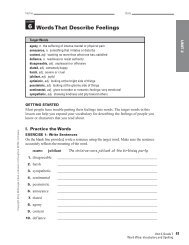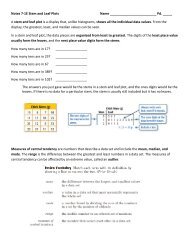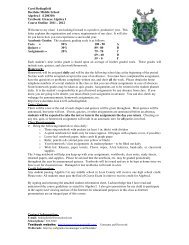DNA Fingerpriniting - An Argument Driven Inquiry Lab Activity.pdf
DNA Fingerpriniting - An Argument Driven Inquiry Lab Activity.pdf
DNA Fingerpriniting - An Argument Driven Inquiry Lab Activity.pdf
- No tags were found...
You also want an ePaper? Increase the reach of your titles
YUMPU automatically turns print PDFs into web optimized ePapers that Google loves.
Biology <strong>Lab</strong> Investigation #10: <strong>DNA</strong> BIntroduction: The term "<strong>DNA</strong>," once used only by scientists, has become an everyday part of ourvocabulary. It's almost impossible to be unaware of the impact that the use of <strong>DNA</strong> has had on everythingfrom the court system to genealogy. It's also nearly impossible to be unaware of the controversy. Now that,theoretically, we could each have a profile that can identify us solely by our <strong>DNA</strong>, many people are worriedabout how that profile might be used.Also known as <strong>DNA</strong> or genetic typing, <strong>DNA</strong> profiling is simplythe collection, processing and analysis of VNTRs -- uniquesequences of bases at several different loci (locations on achromosome). VNTR stands for variable number tandemrepeats -- meaning that the tandem repeats, or pairs ofnucleotides, vary in number. Most <strong>DNA</strong> sequences in differentpeople look too similar to tell apart. After processing, however,VNTRs result in bands that are unique enough to be used foridentification (see Figure 1). Dr. Alec Jeffreys discovered thesedifferences in 1984 while looking at results of an experimentthat used <strong>DNA</strong> belonging to different family members of one ofhis lab technicians. In this lab investigation, you will be using<strong>DNA</strong> profiles to help solve a crime.Figure 1. Banding patterns that result from VNTRsThe Problem: Police have five suspects in a robbery case. At the crime scene police found blood; apparentlythe robber cut him/herself when they were either entering or leaving through a broken window. The courtshave obtained <strong>DNA</strong> samples from the five suspects. As the director of a genetic testing laboratory, you willanalyze the samples using the <strong>DNA</strong> fingerprinting technique to determine if the blood was from one of thesesuspects.The guiding question of this investigation is: Does the <strong>DNA</strong> profile created from the blood found at thecrime scene match the <strong>DNA</strong> profile created from the blood of any of the suspects?Materials available for use: You may use any of the following materials.§ Picture of a gel§ Information about <strong>DNA</strong> fingerprinting and gel electrophoresisSafety Precautions: There are no specific safety issues related to the materials that you will be usingduring this activity. Be sure to follow all normal lab safety rules.Getting Started: It is important for you to learn a little more about how gel electrophoresis works and howto read a <strong>DNA</strong> fingerprint before you attempt to solve this problem. To learn more about howelectrophoresis works go the following website and complete the online activity:http://learn.genetics.utah.edu/content/labs/gel/Once you are finished with the online activity, your teacher will supply your group with a picture of a gel thatyou can use as data to help you complete this lab. A lab technician used the following protocol to create thegel:1
Samples of <strong>DNA</strong> from the crime scene and 5 suspectsCrime Scene 1 2 3 4 5 <strong>DNA</strong> Standard<strong>DNA</strong> is cut into fragments using the EcoRI restriction enzymeCrime Scene 1 2 3 4 5 <strong>DNA</strong> StandardEach sample and the <strong>DNA</strong> standard is loaded into to a different well on a gelCrime Scene 1 2 3 4 5 <strong>DNA</strong> StandardElectrophorese <strong>DNA</strong> samples at 100 Volts for 30 minutes. Then add astain to the gels to make the bands visible.2
<strong>DNA</strong> Structure BCheckout Questions1. How is the diagram below related to the central dogma? Explain your reasoning2. What is a protein? How is a protein related to <strong>DNA</strong> structure?3. When Gregor Mendal was conducting his famous investigations of inheritance with pea plants thestructure of <strong>DNA</strong> was unknown to biologists. How traits were passed from one generation to the next wasstill a mystery. Thanks to the work of Thomas Hunt Morgan, Watson and Crick and many others we nowhave an understanding of the structure of <strong>DNA</strong> and how it relates to inheritance of traits. Does this notionsupport the durable but changeable nature of science? Explain your reasoning5


